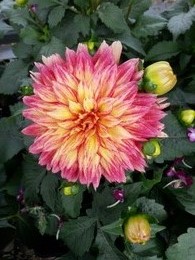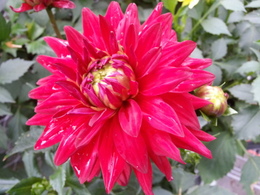Dahlia Growing Guide
Dahlia (Dahlia spp.) is usually grown as an annual planted outside in the spring after all danger of frost is over. It is hardy in USDA Zones 8 to 10 and does best when planted in full sun. They are named after a Swedish botanist Dr. Anders Dahl.
It is a perennial wildflower native from Mexico to Central America that is grown as an annual in most areas. It produces blooms throughout the summer until the first frost. The blooms range in color from red, pink, orange, yellow, violet and white.
The blooms may be described as single, anemone, ball, cactus, collarette, pompom and waterlily.
The dahlia family is very large with thousands of named varieties, but they are often placed into 3-groups based on size.
The large varieties called dinner plate dahlias have blooms 9 to 12-inches in diameter on stems 36 to 48-inches tall. These almost always require some type of staking to support the tall blooms and will look best toward the back of the flower bed.
Medium varieties called border dahlias have 4 to 8-inch blooms on stems 12 to 24-inches tall. These look good along borders in front of taller flowers. They are also grown in containers.
Small dwarf bedding varieties have blooms up to 4-inches on stems 10 to 20-inches tall. You can plant them along the edge of borders, window boxes, planters and pots.
Soil Preparation
Plant them in full sun in a nice loose well-drained garden soil. As soon as the soil is frost-free and can be worked, till the soil by digging down 8 to 12-inches turning the soil over with a garden fork. Remove any large rocks and stones. The small stones remaining will do no harm and actually benefit the soil by adding some micronutrients to the soil. They will do best in a slightly acid soil with a pH range of 6.0 to 7.0.
When to Plant
They should be planted in the late spring after the last expected frost. Dahlias do not like cold soil, so wait until the soil reaches 60-degrees F before planting the tubers. This might be about 2-weeks after the last frost date, which is also about the same time as planting tomatoes.
Planting Dahlias
For potted plants follow the directions on the plant tag. Plant them 12 to 24-inches apart or in groups of 3 or 5 behind other shorter plants. Depending on the variety, typical heights may range from 20 to 40-inches high.
Dig a hole as deep as the pot and twice as wide. To the soil you just removed add the same amount of good garden soil so you have a nice blend of new and native soil.
Take the plant out of the pot and gently loosen the root ball pulling away any roots that have grown in a circle around the pot.
Place it in the hole with the growing crown of the plant even with or an inch higher than the surrounding soil. Gently spread out the tubers and back fill the hole around them leaving a shallow depression around your plant. Fill the depression with water to settle the soil adding more soil if necessary and water again. Water daily tapering off as the roots grow and get established.
Now is the time to put in a support stake so that you do not injure the tuber if you wait to do it later. The large blooms on tall stems are easily knocked down from heavy rain and strong winds.
For bare root plants follow the grower’s directions. In general you can plant the tubers 2 to 4-inches deep and 12 to 24-inches apart with the eye pointing up. At this point just lightly water until you see shoots emerge above the ground and then you can increase your watering.
If you put in the stakes first you will have a very good visual idea of how things will look later. It is then easy to plant the tuber next to the stake.
Watering and Care
Dahlia are low maintenance and easy to care for. All you need to do is add a layer of mulch to help retain moisture and keep out competing weeds. Keep the mulch a few inches away from the stem. They should get an inch of water each week and during dry spells give some water to keep the soil moist. Over-watering can promote some diseases. They usually do not need any fertilizer, but a light side dressing of organic fertilizer can be placed around the plant in the spring.
After the blooms fade remove the entire stem to promote more new flowers to form.
In the fall a hard frost will kill the plant. To save them for next year loosen the soil with a garden fork and pull the tubers out of the ground using the stems as a handle. Shake off any remaining soil and cut off the stems a few inches above the tuber. Put them in a frost free area to dry.
The tubers can then be stored in a paper bag or cardboard box with some peat moss or perlite. Store them over the winter in a cool area that does not freeze, such as a basement. Leave the bag or box open to allow air circulation.
In the spring the Dahlia tubers can be planted whole or the larger clumps can be divided leaving at least 3-eyes per clump.
Diseases
Stem rot often occurs when grown in heavy poor draining soil. The rot advances down and kills the tubers. Do not over water and keep mulch a few inches away from the stems. Next year increase the drainage by adding some sand and raising the bed a few inches higher.
Aster yellows and mosaic virus are other common problems often caused by poor air circulation around the plants. There is no easy cure and best solution is to remove the entire plant including the tubers and tossing into the trash. Do not compost any diseased plants.
Botrytis blight is a powdery gray mold that causes the flower bud to rot. Remove and toss out affected parts.
Many diseases can be avoided by increasing air circulation around the plants. Sometimes buildings and other plants such as hedges can block air circulation. This year the removal of some plants may help. Next year increase the spacing between the plants or try another location.
Pests
Aphids, mites and leaf-hoppers can be knocked off by spraying them with a garden hose. An application of insecticidal soap or neem oil will help. A visit to your Cooperative Extension or full service garden center can help you with the recommended product approved for your location.
Popular Varieties
Dinner plate dahlias: Akita, Babylon Red, Bohemian Spartacus, Kelvin Floodlight, Lavender Perfection, Otto's Thrill, Snow Country, Thomas Edison.
Border Dahlias: Berliner Kleene, Bluesette, Claudette, Margareth Kleene, Orange Kleene, Orange Nugget, Park Princess, Red Pygmy.
Small dwarf bedding varieties: Alfonso, Cher Ami, Connor, Elise, Elizabeth, Granville, Rival, Stillwater Plum, U2 Fire, U2 Will.
Sources: American Meadows, Dutch Bulbs, Eden Brothers.
Garden Spikes newsletters give you timely information once or twice a month. Subscribe Free to the Garden Times newsletter below.
Your email address will only be used to send you a newsletter and will never be sold. You can unsubscribe at any time.


